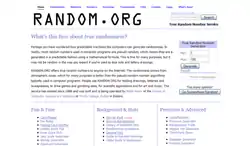Random.org
Random.org is a website that produces random numbers based on atmospheric noise.[1] In addition to generating random numbers in a specified range and subject to a specified probability distribution, which is the most commonly done activity on the site, it has free tools to simulate events such as flipping coins, shuffling cards, and rolling dice. It also offers paid services to generate longer sequences of random numbers and act as a third-party arbiter for raffles, sweepstakes, and promotions.
 Random.org as of October, 2009 | |
Type of site | Web service |
|---|---|
| Available in | English |
| Owner | Mads Haahr |
| Created by | Mads Haahr |
| URL | www |
| Registration | optional |
| Launched | 1998 |
| Current status | online |
The website was created in 1998 by Mads Haahr,[2][3] a doctor and computer science professor at Trinity College in Dublin, Ireland. Random numbers are generated based on atmospheric noise captured by several radios tuned between stations.[4][5]
Bits
A binary digit (bit) can be either 0 or 1. There are several Random.org radios located in Copenhagen, Dublin, and Ballsbridge, each generating 12,000 bits per second[6] from the atmospheric noise picked up.[7] The generators produce a continuous string of random bits which are converted into the form requested (integer, Gaussian distribution, etc.)
Quota
There are limits to the number of bits supplied to a particular IP address. A new user (identified by IP address) starts with a free-of-charge quota of 1,000,000 bits which is depleted every time bits are supplied, and topped up by 200,000 bits (or to 1,000,000 bits if the user has more than 800,000 bits remaining) every day at midnight UTC. Larger numbers of bits can be purchased.[8]
References
- O'Connell, Pamela LiCalzi (2004-04-08). "Lottery Numbers and Books With a Voice". New York Times. Archived from the original on July 26, 2009. Retrieved 2009-10-23.
Other sites also offer true random numbers, said Mads Haahr, lecturer in computer science at Trinity College, Dublin
- McNichol, Tom (2003-08-11). "Totally Random". Conde Nast Publications. p. 2. Retrieved 2009-10-23.
Mads Haahr, a lecturer in computer science at Trinity College in Dublin, designed the system
- Klarreich, Erica (2004-12-04). "Take a chance: scientists put randomness to work". Science News. Archived from the original on 2009-10-23.
Haahr's Web site (//www.random.org/) can generate up to 3,000 random numbers per second
- Johnson, George (2001-06-12). "Connoisseurs of Chaos Offer A Valuable Product: Randomness". New York Times. Retrieved 2009-10-23.
Random.org generates unpredictable sequences of data using a radio tuned between stations, harvesting the atmospheric noise
- Bialik, Carl (2009-10-14). "How Random Is the iPod's Shuffle?". Wall Street Journal. Retrieved 2009-10-23.
- random.org: FAQ
- random.org: History
- "Your Quota". Random.org. Retrieved 2011-10-30.